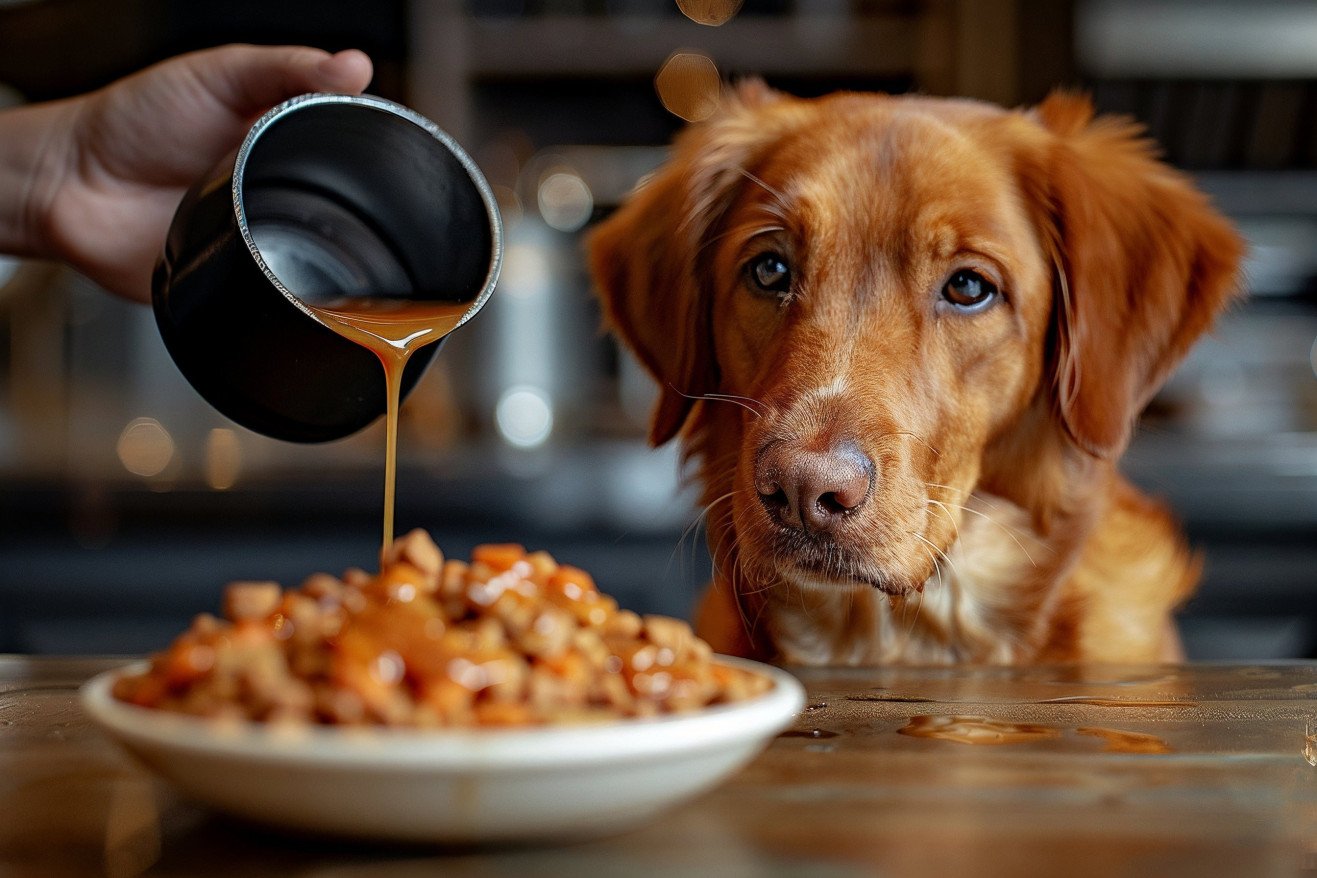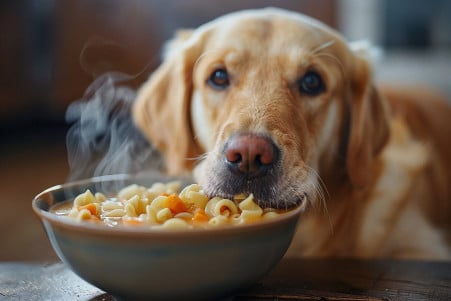Can Dogs Eat Gravy? The Truth About Feeding Pups This Savory Sauce
6 June 2024 • Updated 5 June 2024

If you’ve ever wondered whether you can share your gravy with your dog, you’re not alone. Gravy is a popular addition to many human foods, and it’s natural to want to share a treat with your furry friend. But is it safe to give your dog gravy, or could it be harmful to their health? It turns out that dogs can eat gravy in moderation, but there are some important caveats to keep in mind. For example, you’ll want to make sure that the gravy you give your dog doesn’t contain any toxic ingredients, such as onions or garlic, and that it’s not too high in salt or fat. In general, plain gravies made from meat drippings or broth are the best option for dogs, while rich, creamy gravies should be avoided because they tend to be high in fat.
To help you learn more about whether or not dogs can have gravy, we’ve referenced veterinarians, researched pet nutrition guidelines, and cited professional dog trainers. By combining these different sources of information, including scientific studies and expert opinions, you can get a comprehensive look at the potential pros and cons of feeding gravy to your dog. We’ll discuss the best types of gravy to feed your dog, how much gravy is safe to give them, and any other special considerations to keep in mind to make sure you’re feeding your dog in a way that meets their nutritional needs.
Can dogs eat gravy?
Homemade Dog-Friendly Gravy and Healthier Options
Since many store-bought gravies contain ingredients that can be toxic to dogs, such as onions, garlic, and high levels of salt and fat, there are several healthy, homemade options that you can make for your dog. Dogster notes that it's important to avoid gravies that contain toxic spices and instead focus on feeding your dog healthy, nutritious foods that will help support their health.
For a straightforward, dog-safe gravy, you can make this superfood gravy recipe from The Pet Gourmet: cook ground turkey and liver, add peas and water, simmer, and then blend until smooth. The liver provides vitamin E and the peas provide B vitamins, phosphorus, and potassium.
Rover.com also offers some easy options, including pouring hot water or low-sodium broth over dry dog food, mixing in wet dog food, or blending dog-friendly leftovers, such as unseasoned meats, vegetables, and grains, with a bit of broth. You can also make a gravy out of eggs by mixing them with broth.
These homemade gravy options can help add moisture to your dog's diet, which can help keep them hydrated, while also adding nutrients and appealing smells that can help encourage dogs who are picky eaters. If you need a low-fat or grain-free option, you can simply leave out the oil and grains in the recipes. Unseasoned bone broth can also make a tasty, low-calorie option.
Making these healthy gravies at home allows you to control the ingredients and ensure that you're giving your dog a delicious, nutritious meal topper. With a little creativity, even gravy can be a part of a healthy, balanced diet for dogs.
Symptoms of Gravy Toxicity and What to Do If Your Dog Has Eaten Too Much
The American Kennel Club notes that foods most commonly associated with bacterial food poisoning in dogs include milk and dairy products, sausages, and gravy. However, consuming too much gravy can also lead to other health problems, including gastrointestinal upset, food allergies, or food poisoning.
The PetMD article also says that signs of gravy toxicity can include vomiting, diarrhea, lethargy, and respiratory distress. Gravies that contain onions or garlic are especially toxic and can cause more severe symptoms.
If your dog experiences any symptoms of an adverse reaction to eating gravy, especially if they are experiencing persistent vomiting or diarrhea, Hepper suggests that you call your vet right away. In addition, the American Kennel Club recommends keeping an eye on pet food recalls and throwing out any old or moldy food to avoid food poisoning.
Although most dogs can eat a small amount of gravy on occasion without any issues, it's important to be aware of the ingredients in the gravy and to watch your dog for any signs of a reaction. The best way to make sure that your dog can safely eat gravy is to talk to your vet about it.
Can Chicken Broth Gravy Be a Healthier Choice for Dogs?
Gravy made from unsalted, unseasoned chicken or beef broth can be a healthier option for dogs. According to Bluebird Provisions, a quality chicken or beef broth is full of protein and moisture, as well as important minerals that support a dog's immune system, coat, and digestive health. The site notes that store-bought broths can be full of harmful ingredients, such as onions and too much salt, so it's important to be mindful of the type of broth you're using.
Adding chicken broth gravy to a dog's diet can help increase their moisture and protein intake, as well as provide them with essential nutrients. Keep the Tail Wagging offers a recipe for golden paste gravy, which is made from bone broth, coconut oil, turmeric, and other healthy ingredients, such as ginger and cinnamon. This gravy can be added to a dog's meals a few times a week, especially for older dogs.
If you're making broth-based gravy at home, it's important to use broths that don't contain salt, onions, garlic, or other ingredients that can be toxic to dogs. It's also important to watch your dog's response to the gravy and adjust the recipe as needed based on their dietary requirements and taste preferences. However, with the right precautions, chicken broth gravy can be a healthy and nutritious addition to a dog's diet.
Portion Control and Moderation When Giving Dogs Gravy
Gravy should be used as a special treat for dogs and not a regular part of their diet. Tails.com advises consumers to read labels and look for low-sodium, low-fat options in stores or make their own to make sure the gravy is safe for dogs.
As for portion control, while the Wetlands Canine Recipe with Fowl in Gravy doesn’t list specific serving sizes, you can base the amount you give your dog on their size and weight. Clear Conscience Pet recommends starting with 1 scoop (1.5 tsp) of their SuperGravy mix per cup of kibble or freeze-dried food and adjusting from there.
Gravy can be added to your dog’s meals by pouring it over their food or mixing it in with their kibble. However, overdoing it can lead to health issues like obesity, gastrointestinal problems, and more. Make sure to use gravy in moderation to keep your dog safe and healthy while they enjoy this delicious treat.
Gravy and Dogs with Pre-Existing Health Conditions: Special Considerations
For dogs with certain pre-existing health conditions, such as pancreatitis, consuming gravy can pose significant risks. Volunteer Veterinary Hospital explains that the pancreas releases enzymes to help digest food, but if these enzymes are released outside of the small intestine, they can cause inflammation and organ damage. High-fat foods like gravy are one of the most common triggers for pancreatitis in pets.
According to Southeastern Veterinary Hospital, rich holiday foods including gravy can lead to acute pancreatitis, which causes symptoms like vomiting, diarrhea, abdominal pain, and lethargy. West Park Animal Hospital warns that previous pancreatitis episodes increase the risk of recurrence, making it critical to avoid triggering foods.
For dogs with pancreatitis or other conditions requiring a low-fat diet, All About Dog Food recommends feeding highly digestible proteins and carbohydrates while strictly limiting fats. Consulting a veterinarian is essential before introducing any new foods, including gravy, to ensure your dog's safety and wellbeing. Closely monitoring your pup's reaction and recognizing the signs of potential complications is also crucial.
Conclusion: Gravy Can Be a Safe Treat for Your Dog
Gravy can be a safe treat for dogs, but it’s important to be mindful of portion sizes and the ingredients in the gravy. In particular, it’s important to avoid gravies that contain toxic ingredients like onions, garlic, or excessive salt and fat.
Instead, pet owners can opt for homemade, dog-safe gravy options or healthy alternatives like unseasoned broth or wet food toppers. If you decide to make your own gravy at home, be sure to use broths that don’t contain added salt, onions, garlic, or other ingredients that can be toxic to dogs.
It’s always a good idea to talk to your vet before making any significant changes to your dog’s diet, especially if your dog has a pre-existing health condition. In the end, it’s important to be a responsible pet owner and prioritize your dog’s health.


